#datetime picker jquery
Explore tagged Tumblr posts
Text
Nepali Date Converter || AD to BS & BS to AD
Welcome to the ultimate Nepali date converter, an intuitive Bikram Sambat to Gregorian date converter and vice versa. Our BS to AD converter is a powerful online tool that allows effortless conversion between Nepali to English date converter and English to Nepali date converter. Trusted by users for passports, visas, historical research, and birthday calculations, this free Nepali date conversion tool ensures accuracy across BS (200–2089) and AD (1944–2033) ranges. Experience seamless date conversion with Barala’s top-rated Nepali date conversion tool now!
Discover Barala’s powerful Nepali date converter, a free tool for converting Bikram Sambat to Gregorian and vice versa. Users trust our BS to AD date converter and AD to BS converter for accurate date mapping. Whether you need an English to Nepali date converter, Nepali to English date converter, or simply the best Nepali calendar converter, our site delivers instant results. Built on top of the same libraries that power npm tools like nepali-date-converter and bikram-sambat-js, Barala also features a sleek Nepali date picker for smooth selection. From calculating your BS age calculator to using a planned Bikram Sambat calendar API, this is the go‑to, free Nepali date conversion tool trusted by thousands.
Nepali date converter
Bikram Sambat to Gregorian date converter
BS to AD converter
Nepali to English date converter / English to Nepali date converter
Free Nepali date conversion tool / Nepali date conversion tool
Nepali date converter
Bikram Sambat to Gregorian converter
BS to AD date converter
AD to BS converter
English to Nepali date converter
Nepali to English date converter
Free Nepali date conversion tool
Nepali calendar converter
Nepali date picker
Nepali date‑picker jQuery plugin
React Native Nepali date converter
Nepali‑datetime library
BS‑AD date‑converter
AD‑BS conversion utility
Nepali date formatter
Bikram Sambat calendar API
Nepali calendar API
BS age calculator
Nepali age calculator
0 notes
Text
Add a DateTimepicker to your Ruby on Rails app
I just published "Add a DateTimepicker to your Ruby on Rails app" You often use a datetimepicker in your applications. Here is a step-by-step guide to using it on a Ruby on Rails application
We will see how to add a date and time selector to Ruby on Rails. This way, your users will be able to select a date and period from a calendar. In this example, we will use the bootstrap datetimepicker.
That’s what we’re going to get !
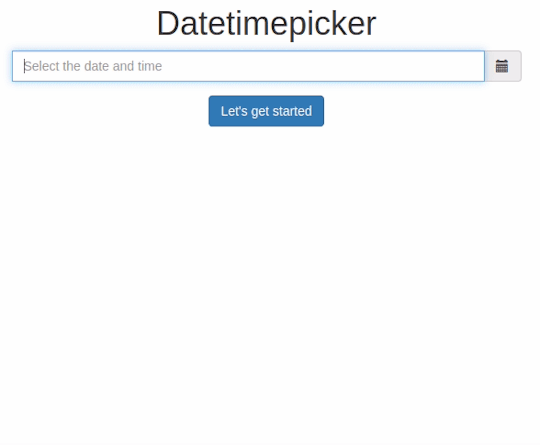
DateTimepicker: Let’s go !
Create a new project with the name of your choice, here “datetimepicker” specifying the use of a PostgreSQL database.
$…
View On WordPress
#bootstrap datepicker#date and time picker javascript#date time picker#date time picker javascript#date time picker js#datepicker datetime#datepicker time#datetime picker#datetime picker jquery#datetimepicker#datetimepicker example#datetimepicker format#datetimepicker javascript#datetimepicker plugin#javascript date and time picker#javascript date time picker#javascriptdatetime picker#jquery date time picker#jquery datetimepicker documentation#js date time picker#time and date picker
0 notes
Text
Select Dates & Times From Form Fields - jQuery moDateTimeField
moDateTimeField is a simple, convenient, mobile-compatible jQuery DateTime picker plugin for the web.
Demo
Download

2 notes
·
View notes
Text
User-friendly Datetime Range Picker With Predefined Date Ranges
User-friendly Datetime Range Picker With Predefined Date Ranges
This is the vanilla JS version of the jQuery Date Range Picker plugin, which allows you to create a customizable, nice-looking date range picker with pre-defined date ranges. How to use it: 1. Load the required moment.js and vanilla-datetimerange-picker.js in the document. <link rel="stylesheet" href="./dist/vanilla-datetimerange-picker.css" /> <script…
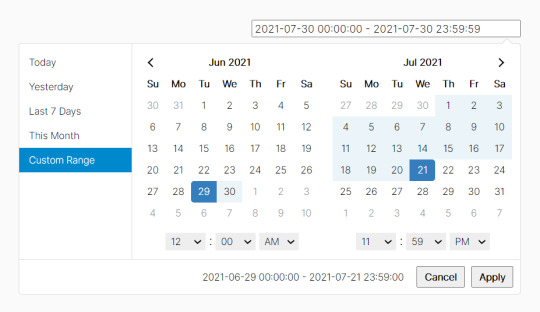
View On WordPress
0 notes
Link
Calendars are an important part of our lives. In today’s world, people mostly use the web or mobile calendars. They can be found everywhere, including various software: booking apps, travel software, project management, admin panels, etc. Users may need calendars on websites for several reasons. The user may need to pick a date from the calendar to fill up a form or provide a date while delivering any information. Undoubtedly, this component can be called critical for business applications. Just imagine how much your business can suffer due to a badly tuned and developed calendar. Thus, this component should be given special attention and meticulousness in development. In this article, we will look at criteria for a good calendar in web applications. Also, we will show you the best libraries in different frameworks for building your own solutions based on them. Qualities of a good calendar for web apps We have picked the criteria for a good calendar from our previous article on date-pickers. Obviously, we can adapt these to calendar plugins. We divided our evaluation criteria into 4 blocks. Documentation. It is vital for whatever you’re using to be well-documented in order to learn how to build or reconstruct it. The product with no or lacking documentation does not have a right to exist. Customization. A great library should come with options that can be updated to add or remove certain functionality. This especially applies to open-source software. Compatibility. Who wants to visit a site with a datepicker that only works in recent versions of Chrome and Webkit browsers? Many business apps still work in legacy browsers. User Experience. Ask yourself whether the plugin will be convenient for the needs of your user? Does it fit your product style? The looks and quality of the docs are not that important compared to how the library will actually deal with your task. Top calendar libraries We have included various calendar libraries based on React, Angular, Vue, Bootstrap or jQuery. Some of them are more developed, some are easier to customize. Hope this catalog will help you in your work. Fullcalendar.io GitHub stars: 9400 Price and License: MIT Website/Demo: https://fullcalendar.io/ Github: https://github.com/fullcalendar/fullcalendar Type of installation: NPM, Yarn Frameworks: React, Vue, Angular This is a good choice for those who know what they want. There are no detailed step-by-step guides that describe what to do to get the goal. Only a brief Getting Started Guide and Documentation Page. Lightweight. The library is easily customizable and has many different components. The website, demos, and documentation give the impression of a mature product, which you’re not scared to use. With this, you can plan resources and mark events. Timeline view and various themes are also there. A good asset of this library is the documentation for developing in React, Vue, and Angular. Tui calendar GitHub stars: 7328 Price and License: MIT Website/Demo: http://ui.toast.com/tui-calendar Github: https://github.com/nhn/tui.calendar Type of installation: Via package managers or CDN Frameworks: React, Vue, Angular wrappers Tui is a part of a TUI library. It is built on top or jquery with options of using React, Angular and Vue wrappers. The calendar supports various view types: daily, weekly, monthly(6 weeks, 2 weeks, 3 weeks) and efficient management of milestone and task schedules. You can change the first day of the week, customize the date and schedule information UI(including a header and a footer of grid cell). The product has full documentation and can be installed via package managers of Content Delivery Network. CLNDR GitHub stars: 2760 Price and License: MIT Website/Demo: http://kylestetz.github.io/CLNDR/ Github: https://github.com/kylestetz/CLNDR Type of installation: Via package managers or CDN Frameworks: React, Vue, Angular wrappers CLNDR.js is a jQuery calendar plugin that, unlike most calendar plugins, doesn’t generate markup. Instead, you provide an Underscore.js HTML template, and in return, CLNDR gives you a wealth of data to use within it. HTML templates are well-suited to this task because they allow us the flexibility to specify where we want the data to go in our markup. CLNDR takes your template and injects some data into it. The data contains everything you need to create a calendar. Kendo UI Scheduler GitHub stars: 2160 Price and License: Apache License, $899 – $2199 Website/Demo: https://demos.telerik.com/kendo-ui/scheduler/index Github: – Type of installation: package managers Frameworks: React, Angular, Vue, jQuery Kendo UI is a big and advanced JavaScript framework. It contains tons of widgets and tools. Maybe it’s not a good idea to use its Scheduler Widget if you’re not interested in other components. The Kendo UI documentation is well written, and you can check out a bunch of Scheduler demos supplemented with code examples. Regarding the coding, it won’t take much time to build a basic scheduler and add some features to it. The default view is a little bit plain, but it’s easy to change that. React big calendar GitHub stars: 3254 Price and License: MIT Website/Demo: http://intljusticemission.github.io/react-big-calendar/examples/index.html Github: https://github.com/intljusticemission/react-big-calendar Type of installation: package managers Frameworks: React React big calendar is an event calendar component built for React. It is made for modern browsers (read: IE10+) and uses flexbox over the classic tables-ception approach. React big calendar includes two options for handling the date formatting and culture localization, depending on your preference of DateTime libraries. You can use either the Moment.js or Globalize.js localizers. Out of the box, you can include the compiled CSS files and be up and running. But, sometimes, you may want to style Big Calendar to match your application styling. For this reason, SASS files are included with Big Calendar. SASS implementation provides a file containing color and sizing variables that you can update to fit your application. Mobiscroll responsive calendar GitHub stars: – Price and License: free, $95, $595 Website/Demo: https://mobiscroll.com/responsive-calendar Github: – Type of installation: copy and paste script Frameworks: Angular, Ionic, React, jQuery, plain JS Mobiscroll calendar is a multiframework responsive calendar, which can work in mobile, web and tablet devices. Together with Single and Multiple selection types, users are able to select not just days one by one, but full weeks as well. It also enables users to easily change years and months without consecutive swiping. Mobiscroll helps users visualize two to three months in a row by displaying multiple months. It can provide helpful information in the form of text in day cells. With Mobiscroll you can highlight dates that have a specific meaning to the users. Additionally, you might use icons and text to give it meaning. The product supports localization and multilingual apps. It provides a UI with the correct culture settings. RTL availability also included. Syncfusion react calendar GitHub stars: – Price and License: $2495 – $4995 for all components Website/Demo: https://www.syncfusion.com/react-ui-components/react-calendar Github: – Type of installation: copy and paste script Frameworks: Angular, Blazor, plain JS, Vue, React The Syncfusion calendar is a component to display the date and days of the week. It provides the month, year, and decade view options to quickly navigate to the desired date. It supports minimum dates, maximum dates and disabled dates to restrict the date selection. The product is lightweight and easily configurable. You can choose across four different themes, including Material design. Apart from the standard, built-in theme, the Calendar component provides complete control over its appearance, allowing you to customize the style to suit your application. Angular calendar GitHub stars: 1662 Price and License: MIT Website/Demo: https://mattlewis92.github.io/angular-calendar/#/kitchen-sink Github: https://github.com/mattlewis92/angular-calendar Type of installation: package manager Frameworks: Angular The product is a calendar component for Angular 6.0+ that can display events on a month, week or day view. The template is highly customizable. You can build your own components instead of those not meeting your project specs. Please note that this library is not optimized for mobile. You will need to do it yourself. Bootstrap calendar GitHub stars: 2867 Price and License: MIT Website/Demo: http://bootstrap-calendar.eivissapp.com/ Github: https://github.com/Serhioromano/bootstrap-calendar Type of installation: package manager Frameworks: Bootstrap Full feature calendar based on the most popular HTML framework Twitter Bootstrap. This product is reusable. It means that there is no UI in this calendar. All buttons to switch view or load events are done separately. You will end up with your own unique calendar design. It is also template based – all views including year, month, week or day are based on templates. You can easily change the looks or style, even add a new custom view. If you use this product, it will be easy to adjust and style your calendar with LESS variables file. It uses AJAX to feed calendar with events. You provide URL and just return by this URL JSON list of events. Language files are connected separately with i18n. You can easily translate the calendar into your language. Holidays are also displayed on the calendar according to your language. Vcalendar GitHub stars: 1316 Price and License: MIT Website/Demo: https://vcalendar.io/ Github: https://github.com/nathanreyes/v-calendar Type of installation: package manager Frameworks: Vue V-Calendar is a clean and lightweight plugin for displaying simple, attributed calendars in Vue.js. It uses attributes to decorate the calendar with various visual indicators including highlighted date regions, dots, bars, content styles and popovers for simple tooltips and even custom slot content. Any single attribute may contain one object of each type and can be displayed for single dates, date ranges and even complex date patterns like every other Friday, the 15th of every month or the last Friday of every other month. Dhtmlx calendar GitHub stars: – Price and License: from $599 Website/Demo: https://dhtmlx.com/docs/products/dhtmlxCalendar/ Github: – Type of installation: package manager Frameworks: Vue, Angular, React This is quite a good choice if a calendar is all you want. There is an example of integration with Google maps, so you can extend the basic functionality if needed. The documentation page contains a set of guides that may be useful for beginners. The bunch of containers needed to make this scheduler work may confuse you from the start, but the overall coding process is quite obvious. The product has the following features: Cross-browser compatibility IE11+ support Full control with JavaScript API Ability to set inactive dates Configurable first day of the week Built-in multilingual support 12-hour and 24-hour time format 3 views: calendar, month, year This is quite a good choice if you want to build an enterprise product. The company has good support and flexibility in prices. Recap and conclusion We had a look at both basic and more advanced calendars. If you want a simple solution without support, but still easily customizable, then choose one of the free options. Considering more complex products, we presented paid solutions with good support quality. About Flatlogic At Flatlogic we develop admin dashboard templates and React Native templates. We are listed among Top 20 Web Development companies from Belarus and Lithuania. During the last 6 years, we have successfully completed more than 30 big projects for small startups and large enterprises. As a team, we always have a deep desire to help our clients. You might also like these articles: Originally published at flatlogic.com — React, Angular, Vue, Bootstrap & React Native templates and themes. Text source: Top Javascript Calendar Plugins
0 notes
Photo

V8 v8, the State of JS survey results, and CDNJS lives
#468 — December 20, 2019
Read on the Web
If you're subscribed to any of our other newsletters, you'll have seen we're doing 2019 roundups this week.. but not in JavaScript Weekly! :-) Our 2019 JavaScript roundup will be here on January 3, but today is a normal issue. Happy holidays!
JavaScript Weekly
Tesseract.js 2.0: Pure JavaScript OCR for 100 Languages — A pure JavaScript port of the popular C++ Tesseract library commonly used for visual text recognition purposes by other systems. The homepage has a neat demo where you can drop on images of your own and see how they get processed. v2.0 is now out and here's why the creator has been working on it.
Jerome Wu
V8 Release v8.0 — Yes, that’s v8 of v8 – not confusing at all 😂 Nonetheless, it’s a key step forward for the most widely deployed JavaScript engine, and introduces optional chaining, nullish coalescing, and some significant performance improvements. It’ll be landing in a Chrome and Node near you soon.
Leszek Swirski
Learn the Full Stack with Jem Young, Senior Software Engineer at Netflix — Become a more well rounded engineer by understanding what is happening on the server-side.
Frontend Masters sponsor
Results from the 'State of JavaScript' 2019 Survey — While the methodology is far from perfect (for example, Angular and Angular.js seem to get lumped together as the same thing), this is nonetheless the biggest JavaScript-specific survey. There’s a lot to dig through, so you may prefer The Changelog's 7 insights from the State of JS 2019 roundup post that looks at the most striking results.
Sacha Greif, Raphaël Benitte and Amelia Wattenberger
An Update on CDNJS — CDNJS is a popular content distribution network for JavaScript files but just a couple of months ago its continued development was in doubt. In this significant update we learn more about how CDNJS works and how Cloudflare want to take it forward (and they need our help).
Zack Bloom
Mastering console.log Like A Pro — This isn’t exactly new ground, but if you’re a heavy console.log user, this article deftly covers a variety of extra console methods to keep on your radar.
Harsh Makadia
⚡️ Quick Releases
Node.js 13.5.0
Material UI 4.8 — Popular React components system.
Relay 8.0 — GraphQL client and integration for React apps.
sql.js 1.1 — SQLite, but compiled to JavaScript.
Cash 5.0 — jQuery-style DOM manipulation for modern browsers.
💻 Jobs
Backend Engineering Position 🤘 in Beautiful Norway 🎉 — Passion for JavaScript, GraphQL, Scalability and Performance? Want to move to Norway? Join our fast growing e-commerce service Crystallize.
Crystallize
Find a Job Through Vettery — Make a profile, name your salary, and connect with hiring managers from top employers. Vettery is completely free for job seekers.
Vettery
Technical Content Producer (Interim) at Ably (London, Remote OK) — Ably builds tools and cloud infrastructure for the realtime internet. They need a developer/tech writer on a temporary basis to coordinate, outsource, and review the creation of technical content for a developer audience.
Ably
📘 Articles & Tutorials
What's Coming in Angular 9.0.0 and Ivy Improvements — Angular 9.0 was due to be released this year but is being held back until next year to give the team a break. Nonetheless, it’s going to pack in some key improvements.
Mike Hartington
An Introduction to Controlling the Raspberry Pi 4's GPIO Pins from Node — If you’ve got a Raspberry Pi sat around (I have a few!) and you’re looking to have a play over the holiday season, you could start here.
Uday Hiwarale
Migrating a Distributed System from JavaScript to TypeScript — Learn how to migrate a globally-distributed system written in JavaScript over to TypeScript.
Ably sponsor
Understanding Decorators in JavaScript — Decorators are a first-class concept in some languages that can be used to quickly modify functions or classes by way of a simple directive. The idea is still merely a proposal for JavaScript, but it’s possible to adapt some of the ideas now with Babel.
Mike Green
A Case for Using void in Modern JavaScript? — Some interesting points here. I doubt they’ll take off, but I like the examples.
slikts
Writing JavaScript With Only Six Characters — A fun article like this tends to do the rounds each year and it never ceases to delight me at how quirky JavaScript can be.
Erik Wendel
Const Assertions in Literal Expressions in TypeScript
Marius Schulz
What’s New in Preact X? — Preact is a lightweight React alternative with React API compatibility.
Ogundipe Samuel
Sentiment Analysis of Your Year with TensorFlow.js — Perform sentiment analysis with TensorFlow in JavaScript to determine the positivity of text messages received via Twilio.
Lizzie Siegle
BDD vs Executable Specifications
Gauge sponsor
▶ The Design Principles of Vue 3.0 — A 50 minute talk from the creator of Vue.js, Evan You, on the principles behind the changes coming in Vue 3.0.
Evan You
10 Useful Angular Features You’ve Probably Never Used — Assuming you actually use Angular in the first place, naturally.
Chidume Nnamdi
Why Svelte Won’t 'Kill' React
Kit Isaev
🔧 Code & Tools
A-Frame 1.0 Released: Framework for Building VR Experiences — A-Frame handles the 3D and WebVR boilerplate required to get running across numerous platforms quickly. Version 1 boasts full WebXR support.
A-Frame Team
Introducing Scully: The Angular Static Site Generator — The Angular community now has their very own static site generator.
Netlify
Polly.js 3.0: Record, Replay, and Stub HTTP Interactions — A library from Netflix for recording, replaying and stubbing HTTP interactions via native browser APIs. GitHub repo.
Netflix
▶ From NodeConf EU: What's Being Built and Where Node.js Is Heading
Heroku sponsor
Sarus: A Client-Side Library for WebSockets — Helps you handle situations where connections unexpectedly close.
Anephenix
Alpine.js: A Minimal Framework for Composing Behavior in Your Markup — “Think of it like Tailwind for JavaScript.”
Alpine.js
vue2-datepicker: A Date / DateTime Picker Component for Vue
xiemengxiong
If you're celebrating, we hope you have a happy holiday season and we'll see you in the new year on January 3, 2020.
by via JavaScript Weekly https://ift.tt/2Z90iZH
0 notes
Link
Bootstrap Date Time Range Picker jQuery Plugin – daterangepicker.js https://www.latestblog.org/bootstrap-date-time-range-picker-jquery-plugin-daterangepicker-js/ Bootstrap Date Time Range Picker jQuery Plugin – daterangepicker.js – A simple and flexible, customizable, convenient date and datetime range picker plugin for jQuery that allows to quickly select a date range between two dates. It is helpful for booking website where user’s need to select to and from date like Latest Blog
0 notes
Link
WP Job Manager Field Editor is the only plugin that will allow you to completely customize all form fields for WP Job Manager. Not only will you be able to customize all of the default fields for submitting job posts, but you will also be able to create your own custom fields as well. Want to change the wording for the label of a default field? Maybe you want to change the placeholder (text inside input field), or disable it completely, well WP Job Manager Field Editor does all of that and more! You can also now completely customize the way custom fields are output, use the Automatic Output feature or integrated Widget with numerous output types (oEmbed, Video, Link, etc). WP Job Manager Field Editor Addon Features : Create unlimited custom Job, Company, and Resume Fields, using any of the available field types: Google AutoComplete, Range Slider, Number Spinner, Text Box, Text Area, WP Editor, Dropdown, Phone, File Upload, Password Text Box, Date Picker (jQuery UI), Range & Multiple Date Picker (flatpickr), Time Picker (flatpickr), Checkbox, Radio Buttons, Multiselect, HTML, Section Header, Action Hook, HTML5 Email, HTML5 Tel, HTML5 URL, Hidden Fields,etc.. Conditional Fields (show/hide fields based on value or selection of another field, with unlimited custom logic configurations) https://plugins.smyl.es/docs-kb/conditional-fields-beta/ Completely customize conditional logic transitions using Velocity.JS Completely customize default Job, Company, and Resume Fields ( edit, disable, view, etc ) Numerous settings including admin only, maxlength, placeholder, required, ajax file upload, max file size, multiple file upload and more! Taxonomy Field Types ( Checklist, Multi-Select Dropdown [jQuery Chosen], Dropdown ) – Requires WP Job Manager >= 1.14.0 Save date field types using your pre-defined or custom formats (epoch, MySQL DATETIME, etc) Backup, and Restore Fields Backup, Edit, and Restore Conditional Logic through JSON UI Builder/Editor Automagically set the Featured Image of listing by using featured_image meta key Label and Description for fields support HTML (so you can do things like add required checkbox field that says “Yes, I agree to the Terms and Conditions” in the description, and more!) Custom caching built-in using transients and object caching, no excessive added load or db queries! Numerous Video Tutorials available! Download Now WP Job Manager Field Editor Addon at WooCrack.us. You’ll receive the exact .zip file you would download from the original author. If you buy on woocrack.us, you can save your money up to 99% and 100% virus free.
0 notes
Text
Calentim - Date Time Range Picker (Calendars)
Calentim – Date & Time Range Picker
Calentim is a Date/Time Range Picker plugin, built using jQuery and moment.js libraries. It can also be used as a single date/time picker besides the range selection feature. Can be shown inline or used as a dropdown beside an input.
Features
Option to hide specific parts of the instance (header, footer)
Mobile friendly (both portrait and landscape layouts are supported)
Support for predefined ranges
Can be shown as an inline control
Wide localization support (Available languages)
Can also be used as a single datetime picker
Sass template included
Grunt file included
How to build
First install node.js from here nodejs.org, then run npm install in the projects main directory. (inside calentim folder) NPM will install the required packages to build this script. then to minify javascript and to generate css from scss files, you only need to run grunt in the same directory. It will build the source files into build/ directory. Then you can use the minified versions if you want.
Screenshots
Default dropdown style:
Inline 3-calendars style
Mobile portrait view
Mobile landscape view
from CodeCanyon new items http://ift.tt/2r0SabN via IFTTT https://goo.gl/zxKHwc
0 notes
Link
Speckyboy Web Design Magazine http://j.mp/2ggYOKV
Select menus are a common choice for date pickers since they’re easy to set up. But after decades of MM/DD/YY menus, I think our users deserve better.
It’s pretty simple to add a date picker to your form, and most date picker plugins are totally free. Once you learn the basic setup process, you’ll never go back, so it’s really just a matter of finding a good one. I’ve scoured the web in search of the best plugins and organized them all in this post.
You’ll find vanilla JS plugins, jQuery plugins, and even extensions for frameworks like Bootstrap. No matter what you need there’s bound to be a plugin here for you.
1. Flatpickr
The lightweight Flatpickr plugin is easy to use and even easier to setup. It’s designed with simplicity in mind so the default UI should blend into any layout.
If you take a peek at the examples page you’ll notice this datepicker isn’t very complex. But that’s often what users want: a simple interface to input data and move on.
With Flatpickr you can customize the initial date, month, and year along with restrictions on which date(s) can be picked. Plus you can add an optional time parameter using the 12H or 24H clock.
No doubt this is one of the better date picker plugins just for its design, UX, and features.
2. Pickadate.js
Another choice I really like is the Pickadate.js plugin. This is designed to be mobile-friendly and fully responsive so it’s a great solution for all devices.
Pickadate runs on jQuery, so you do need that library as a dependency. However, this file is pretty lightweight, and it doesn’t take much to get it working so even with jQuery you shouldn’t notice any page lags.
This offers both a date and a time selection menu, so it’s a fully-featured option no matter what data you’re collecting.
3. Date Range Picker
Input range pickers are extremely common with scheduling programs and visual data applications. For example Google Analytics uses their own date range picker for visitor data over a specific website.
To recreate this effect try the Date Range Picker. It’s designed to fit into Bootstrap’s CSS stylesheet but can also be used solo.
Plus it supports multi-month pickers, single month pickers, and pre-defined values for common date ranges(past week, past month, etc).
By far the most well-designed JS range selection plugin I’ve ever seen.
4. Datepair.js
To use something a little simpler for range selection try Datepair.js.
This relies on dual input fields for selecting the starting date & ending date of a range. It can also include time ranges too based on your settings and how you configure the plugin.
Is this better than a single date picker UI? That’s up to you(or your client) to decide.
But this is a simple plugin to setup and your visitors may prefer the single field inputs.
5. DateTimePicker
Here’s one of the more unique plugins out there with quite an abnormal interface.
The DateTimePicker plugin has its own responsive dropdown menu that lets the user select their date/time using plus & minus icons.
On the one hand, this is easier to jump around and quickly change the month/year with a few taps. But it’s also not the typical calendar UI so it may take some adjusting from users who aren’t familiar with this interface.
There’s pros & cons to everything, so I say take a peek at the plugin and see what you think. This does support separate date & time inputs, but you can also combine them together making datetime selection just one click away.
6. glDatePicker
For a detailed design and tons of optional features check out the glDatePicker plugin. It’s fairly lightweight considering how much you get and it measures about 7KB when minified.
This runs on top of jQuery, so you have to consider that as well. But it’s one of the few plugins that offers gorgeous theming for calendar date selection screens.
It has a few pre-designed templates, but it also comes with CSS properties that you can restyle yourself. Not to mention all the JS functions have callbacks so if you’re comfortable with coding you can add your own features into the mix.
7. Wickedpicker
While this isn’t technically a datepicker it is one of the better time pickers out there.
Wickedpicker is a jQuery-powered time selection plugin that works on any input field. It supports user input for hours/minutes and the AM/PM setting. You can also run it on a 24h clock with a simple JS option.
Some datepicker plugins have time selection, but it comes as an extra feature. This plugin is designed solely for time inputs, so it’s a nice choice if that’s all you need.
8. Bootstrap Datepicker
Anyone who’s familiar with Bootstrap knows just how useful it is for new projects. If you’re frequently designing sites on Bootstrap then you should keep this Bootstrap Datepicker saved.
It’s one of the few plugins made specifically for BS3 layouts, and it should be compatible with the upcoming Bootstrap 4 release too.
The design includes a section for changing the month & year along with a time selector for altering minutes/hours in your date picker. It blends perfectly into the BS GUI so it’s no doubt a staple for anyone using Bootstrap.
9. Foundation Datepicker
Another popular frontend framework is Foundation and if you’re more into that library you should check out this Foundation datepicker also 100% free.
It also comes with a time picker and options to include the time inside the date selection screen. You can even define dates based on fixed settings(i.e. only certain dates available) and limit those dates to certain times.
You can even restyle the time input with fixed choices like 15-minute intervals.
There’s a lot you can do with this plugin, so it’s a great addition to any Foundation website.
10. FoxRunSoftware DatePicker
This is one of the top plugins on GitHub for jQuery datepickers. It’s simply titled “DatePicker” but to distinguish it from the rest it’s the plugin designed by FoxRunSoftware.
It comes with a clean interface, and by default, it uses a 3-month GUI window for date selection. This feels just like the Google Analytics picker except it’s a bit smaller.
The callbacks are pretty simple to code, and you have a lot of control over how to manage the UX. Certainly a datepicker worth saving if you want to replicate the Analytics GUI.
11. jQ Datepicker
Here’s one more datepicker plugin with the simple title of Datepicker. Again it runs on jQuery but this one’s designed by a Chinese developer Fengyuan Chen.
This Datepicker plugin is phenomenal and it has a ton of documentation for newer JS developers.
The main demo page is great for toying around but check out the GitHub repo if you want to get this plugin setup & running on your website.
And if you’re ever looking for more datepicker plugins try searching GitHub. Web developers release new plugins all the time so you never know what you’ll find.
The post 10 Free Open Source Date Picker Plugins appeared first on Speckyboy Web Design Magazine.
No related posts.
http://j.mp/2ghp4or via Speckyboy Web Design Magazine URL : http://j.mp/2cvndsh
0 notes
Text
Customizing Bootstrap Layouts: Trends, Tools & Frameworks
Bootstrap is currently the number one front-end framework and easily the quickest way to build layouts. It has been around for years and third-party developers have even published their own resources online. These resources range from free themes to detailed plugins and frameworks.
Bootstrap 4: New & Cool Features You’ll Love
Bootstrap 4: New & Cool Features You’ll Love
The next major release of the Bootstrap framework is around the corner. The alpha version can already be…Read more
In this article, I would like to share a handful of these resources and best practices for developers who want to go further with Bootstrap.
All the resources in this post are free, so you can use them however you see fit. Even if you have never used Bootstrap you’re sure to find something here that will help you get started.
Restyling with Bootstrap
The default Bootstrap library comes with its own unique design that looks fantastic. It’s widely known across the web and you can easily tell when a website is using traditional Bootstrap elements.
But, you can also restyle these elements yourself to use Bootstrap’s code as the foundation for your layout.
There are a few different ways you can do this:
Add your own stylesheet to overwrite the default.
Customize BootStrap’s output, so you only get the elements you want.
Combine with add-ons and plugins/themes.
That last option is the most common and it’s one of the reasons Bootstrap has grown so fast.
Granted I’m also a huge fan of their customize tool because it’s totally free and gives you so much control over which features you want to use.
There are tons of resources for BootStrap 3/4, created by third-party developers, so it’s easier than ever to create your own unique BootStrap layouts without writing much code.
Plugins & add-ons
Since Bootstrap comes with a massive JavaScript library, it’s easy enough to expand JavaScript features. And developers have certainly done so with their own plugins, many released for free online.
These are my favorites that all support Bootstrap natively. Many of them run on jQuery, so they are also easy to customize if you know your way around the jQuery library.
Form validator
First up is my favorite form validation plugin, Form Validator. It runs on jQuery and it supports a whole heap of frontend frameworks: Bootstrap, Foundation, Pure, UIKit, and others.
You can manually append any number of 51 validators to any form on your site. This means visitors will need to meet those validation requirements before they can submit the contents.
Many contact forms use these validators to require working email addresses. But, you can also use them for image uploads, or passwords, pretty much anything your Bootstrap-heart desires.
Datetime picker
Date pickers are also a huge pain to code yourself. Many forms just use dropdown menus for the day/month/year settings but you can also use this Bootstrap date picker plugin to save yourself the hassle.
It’s completely open-source and runs on the Bootstrap 3.x library. You will also notice it supports both the date and time by using another jQuery plugin, Moment.js.
Overall, this library is fantastic to get a working date picker active. It does have a lot of dependencies but, thankfully, you won’t need to write much code to get it working.
Star ratings
Here’s another cool feature for star ratings on the web. You can append a one-to-five star rating anywhere on your site, using the Bootstrap library for JavaScript behaviors.
When the user hovers over these stars the display changes to whatever the rating is based on their cursor position. Then, with one click, the user casts their vote and sets a star rating, including half-star ratings.
This plugin is definitely complicated to set up because you can change a lot of the default settings for more advanced techniques. But, you can see a simple live demo to gauge if this star rating plugin fits with your site.
WATable
Bootstrap comes with its own table layout style for displaying tabular data on the frontend. But, with the WATable plugin, you can add a whole bunch of extra features to your Bootstrap tables.
This is one of the most detailed jQuery plugins out there and these are just some of the features you can add:
Custom pagination.
Column sorting.
Data filtering.
Table animation effects.
Check-to-select entire rows.
WATable is described as a Swiss Army knife of table plugins and I have to agree with this description. The fact that it supports Bootstrap is just the icing on the cake.
These were some of my favorite plugins but there are so many others out there. You can browse through even more on this page if you’re curious.
Bootstrap frameworks
Bootstrap is actually a large framework because it lets users customize the default HTML and CSS styles with a few classes.
But, developers have taken the default BootStrap library and added their own styles to create even larger frameworks that work like themes, so you don’t need to restyle Bootstrap from scratch.
Thankfully, they’re all free and they all run on the default BootStrap classes.
Bootflat
Perhaps the most well-known BootStrap framework is Bootflat UI that follows the flat design trend.
It works with all the default Bootstrap features, including all JavaScript components. The major differences are more in design and structure where page elements use flat color schemes to move away from Bootstrap’s gradient styles.
Bootflat hasn’t been overused very much, so you can add this framework on any landing page or homepage to create a unique look for your site.
It’s 100% free and even comes with a color picker, so you can find flat color schemes to match your layout.
Get Shit Done
This surprisingly blunt UI kit also builds on top of the Bootstrap 3 library and it’s released for free on GitHub.
Get Shit Done comes from the team at Creative Tim where they do sell a few premium resources. This specific UI kit does have a pro version but it’s not necessary at all.
The open-source version has more than enough for everyone and you can check out the live demo to see how it looks like in the browser.
Bootstrap material design
Another popular design trend is Google’s material design. This is a design language originally made for Android app designers but has since spread onto the web and garnered lots of support from UI/UX designers.
This incredible Bootstrap material framework uses the material design features to build a custom design style out of Bootstrap’s library.
By default, it supports everything in BootStrap 3 and is currently being reworked to also support Bootstrap 4. You can learn more on the official homepage which has documentation and demos.
A similar library you might try is MDBootstrap, although I find this one a little more difficult to work with.
Bootplus
Google did create the material design language but they also have their own styles for many of their tools and web apps.
Bootplus mimics the Google+ interface style, along with many of Google’s help docs, Google Drive, and similar web apps. It has all the same features as Bootstrap, including grids, layout styles, element styles, and JavaScript components.
You can even browse through a demo on the site to see the differences between Bootplus and the original Bootstrap UI. For a free resource, Bootplus is extensive and it’s perfect for anyone who likes Google’s design techniques.
Tools & resources
Lastly, I want to dive into the many free tools for customizing and building Bootstrap layouts.
These tools are all web apps and many of them are even open-sourced on GitHub. They’re made to save you time and help you design incredible Bootstrap layouts without much code.
Live editor
The free Bootstrap live editor is one of the best tools for non-technical designers. If you don’t know how to code you can still rely on this Bootstrap builder to create a whole layout from scratch.
It runs right in your browser and you can even pick from pre-made templates to get started.
Options in the sidebar let you add certain CSS values if you do know some frontend coding. But, you can also use the GUI to change colors, fonts, sizes, and pretty much anything else you like.
Once you’re done, click “Get theme” and you can copy/paste the updated CSS styles into your own project. Super easy way to restyle Bootstrap without needing to recode everything from scratch.
Form builder
This free Bootstrap form builder is a drag-and-drop browser tool that allows you to create Bootstrap forms from scratch.
Again, it requires zero coding knowledge and you have full access to all Bootstrap 3 elements. Just select the element you want and drag it right into the left-hand box. From here, you can change everything from the placeholder text to the CSS class.
By far the coolest form builder I’ve ever seen and it’s 100% free!
BootSwatchr
Another free tool I really like is BootSwatchr. It relies on the Bootstrap framework and it lets you update colors, theme styles, and the overall layout of the page.
What I like about this app is how it also comes with a free gallery of pre-designed styles.
So, you can download a design that someone else already made or you can use that as a starting point to customize your own theme.
Moving Forward
Bootstrap is only growing in popularity, so now is the best time to dive into this framework. Thankfully, there are dozens of plugins, frameworks, and free tools you can use to expedite the dev process.
In this article, I just showed the tip of the iceberg, so if you don’t see anything here that’s useful get out to Google and see what else you can find.
Using Bootstrap 3 With Sass
Using Bootstrap 3 With Sass
Bootstrap comes with Responsive Grids, and a few common web components that we can pick up to build…Read more
via Hongkiat http://ift.tt/2uD3KyT
0 notes
Text
MAYO 24,2017
Los nuevos input HTML5 para formularios
Toca el turno de repasar cada uno de los nuevos input HTML5. Ya he ido haciendo post de cada uno de ellos, pero ahora voy a realizar un listado y breve resumen de cada uno.
Otros post interesantes son:
Nuevos input de fecha y hora en HTML5
Los nuevos atributos HTML5 para inputs y formularios
Lista de elementos y atributos obsoletos en HTML5
Tal y como sabréis tenemos muchas razones para usar estos input HTML5 y otras para no usarlos de momento:
PROS: Ahorro considerable de código combinando los nuevos input y atributos. De esta manera no necesitaremos realizar tantas validaciones usando PHP, jQuery o similares.
CONTRA: Al no estar estandarizado HTML5 hace que aún haya elementos que no se representen en bastantes navegadores.
Voy a realizar un listado de cada elemento y posteriormente hago un breve resumen de cada elemento para formularios en HTML5:
Datalist
Keygen
Output
Number
Range
Tel
Email
Color
Search
Url
Date
Datetime
Datetime-local
Month
Time
Week
Sacado de: http://www.anerbarrena.com/nuevos-input-html5-3739/
VALIDACIÓN DE FORMULARIOS CON HTML5 Y EXPRESIONES REGULARES SIN USO DE JS. UTILIZACIÓN DE CSS Y FONTAWESOME PARA MOSTRAR CAMPOS VÁLIDOS EN FORMULARIOS
Con la nueva versión de HTML5 se han incluido dentro de los controles de formulario nuevos formatos que permiten especificar el tipo de dato a incluir en una etiqueta <input> y que explicaremos brevemente sólo como introducción. Mucho más interesante es el atributo pattern que estudiaremos. El atributo pattern permite en cualquier campo <input> de tipo texto y utilizando las sobradamente conocidas expresiones regulares delimitar exactamente la sintaxis de una cadena válida. Incluso con CSS3y webfonts como Font Awesome podremos indicar de forma dinámica sin emplear JavaScript si el contenido de un campo es válido o no.
Pulsando sobre el siguiente botón tendrás acceso al ejemplo explicado en este artículo y a todo el código empleado.
ALGUNOS DE LOS NUEVOS TIPOS DE CAMPOS INTRODUCIDOS CON HTML5
No es ninguna novedad enumerar los nuevos tipos de campos introducidos por HTML5, pero siempre hay algún despistado. Es una forma bastante sencilla de incluir una validación básica simplemente delimitando el tipo de datos a incluir. Relaciono los más conocidos, pero ojo: hay algunos navegadores modernos que aún no los reconocen.
Si os interesa este es un buen recurso donde comprobar el soporte de formularios en distintos navegadores: http://www.wufoo.com.mx/html5/
type=”number” Podemos enviar enteros, estableciendo un mínimo y un máximo como input de texto.
type=”range” Podemos enviar enteros, estableciendo un mínimo y un máximo utilizando un control gráfico.
type=”color” Nos permite seleccionar desde un “color picker” un color y enviarlo como hexadecimal.
type=”date” Nos permite seleccionar una día concreto. En los navegadores más avanzados aparece un calendario.
type=”month”, type=”week”, type=”time” Nos permiten seleccionar distintas unidades de tiempo: mes, semana o año.
type=”email” Permite enviar una dirección de email con una pobre validación a nivel de cadena.
type=”url” Permite enviar una url con una pobre validación a nivel de cadena.
type=”tel” Para el envío de números de teléfono.
type=”search” Para definir campos de búsqueda, aunque realmente se comporta como un campo de tipo texto.
Si queréis conocer con más detalle el funcionamiento de estos nuevos controles de formulario os este enlace en W3Schools: http://www.w3schools.com/html/html_form_input_types.asp
Visto lo anterior en cierto modo podemos comenzar a tener cierto control sobre los tipos de datos que pueden admitir los campos input. Hasta ahora con el atributo maxlength podíamos establecer cual era la longitud máxima de una cadena (pero no su mínimo o fijar un tamaño exacto).
Ahora con la inclusión de tipos de datos como email, tel, date, number o url podemos afinar más en el tipo de dato válido. Sin embargo sigue sin ser suficiente.
sacado de: https://oscargascon.es/validacion-de-formularios-con-html5-y-expresiones-regulares-sin-uso-de-js-utilizacion-de-css-y-fontawesome-para-mostrar-campos-validos-en-formularios/
0 notes
Text
[FECHA PUBLICACIÓN 2017-05-16]
Se siguió trabajando con el proyecto con sus respectivas bases, Los requisitos para ganarse un gran beneficio seria terminar más rápido que el otro grado.
----------------------------------------------------------------------------------------------------
Por otro lado:
1)Los nuevos input HTML5 para formularios
Formularios en HTML5
HTML5
Nuevos input, etiquetas y atributos en HTML5
Toca el turno de repasar cada uno de los nuevos input HTML5. Ya he ido haciendo post de cada uno de ellos, pero ahora voy a realizar un listado y breve resumen de cada uno.
Otros post interesantes son:
-Nuevos input de fecha y hora en HTML5:
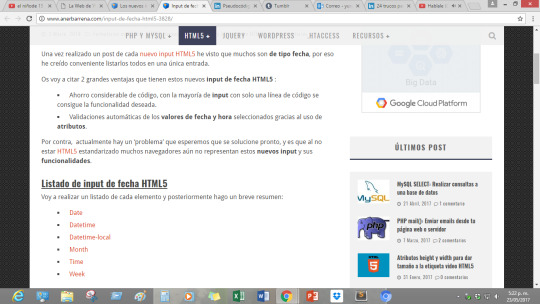


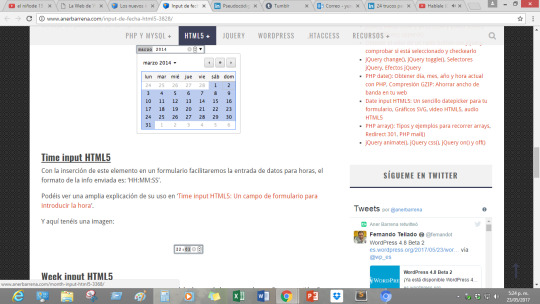
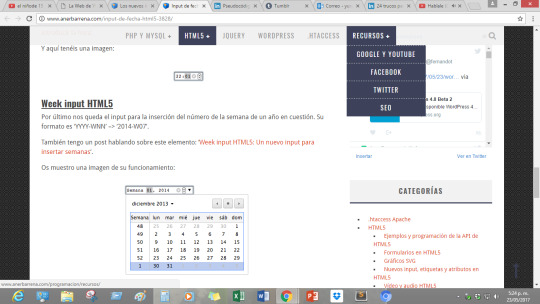
-Los nuevos atributos HTML5 para inputs y formularios:
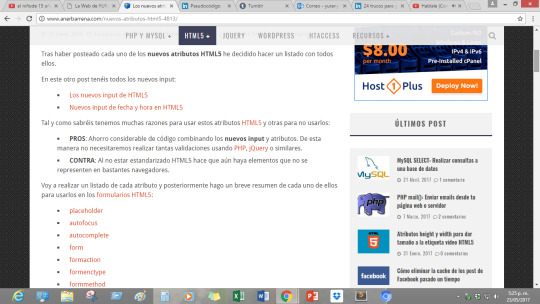
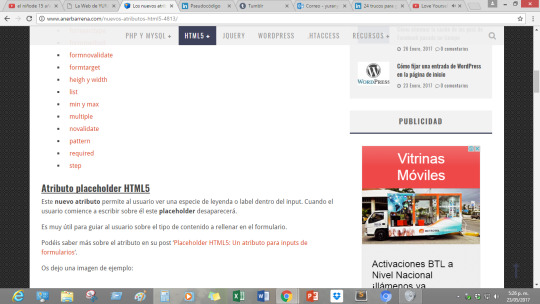
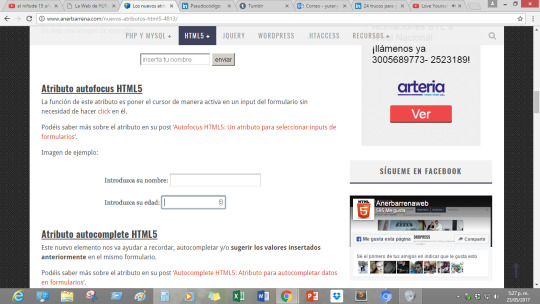
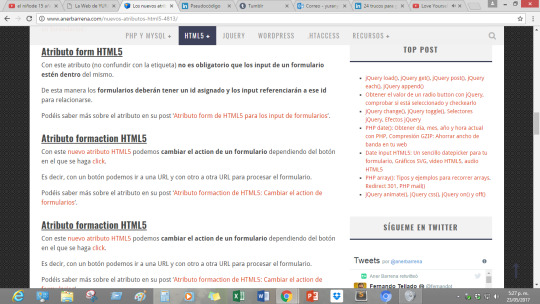
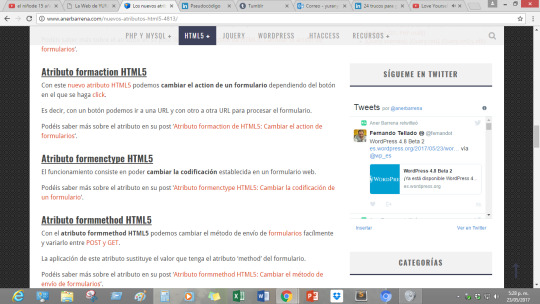
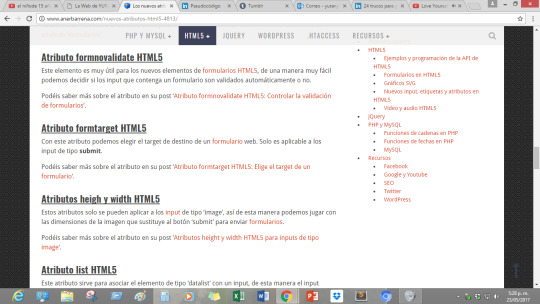
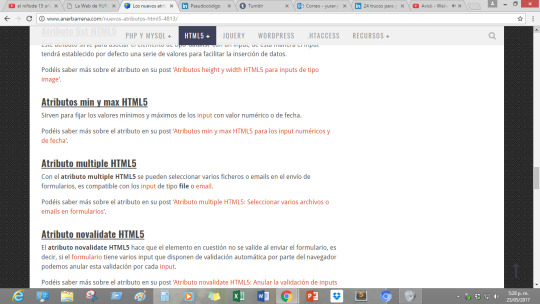
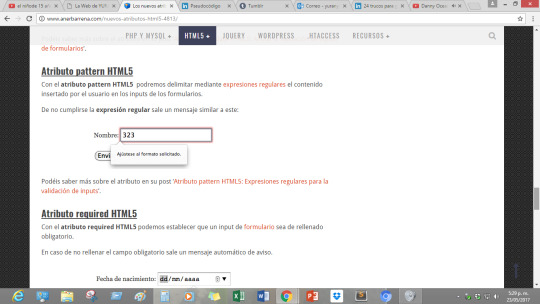

-Lista de elementos y atributos obsoletos en HTML5
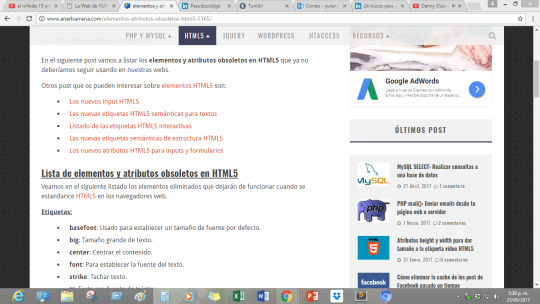
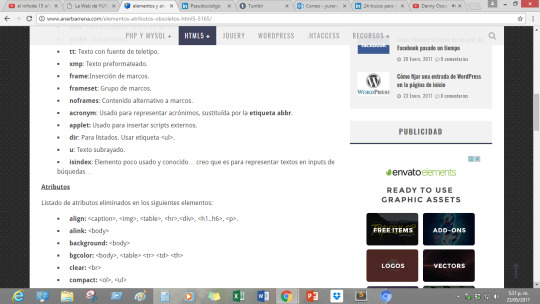
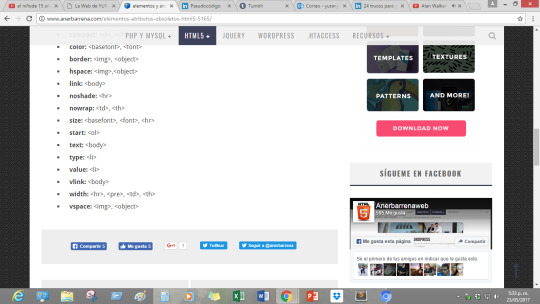
Tal y como sabréis tenemos muchas razones para usar estos input HTML5 y otras para no usarlos de momento:
PROS: Ahorro considerable de código combinando los nuevos input y atributos. De esta manera no necesitaremos realizar tantas validaciones usando PHP, jQuery o similares.
CONTRA: Al no estar estandarizado HTML5 hace que aún haya elementos que no se representen en bastantes navegadores.
Voy a realizar un listado de cada elemento y posteriormente hago un breve resumen de cada elemento para formularios en HTML5:
Datalist
Keygen
Output
Number
Range
Tel
Email
Color
Search
Url
Date
Datetime
Datetime-local
Month
Time
Week
Datalist input HTML5
Este nuevo elemento aglutina varios valores predefinidos que facilitan el autocompletado de un campo tipo input.
Es decir, según el usuario va escribiendo, el navegador abre una lista desplegable con las diferentes opciones a seleccionar. Es muy parecido a un combo o lista.
Podéis ver la documentación y ejemplos en el post ‘Datalist en HTML5: Sugiere una lista de valores en un form‘.
Os dejo una imagen de ejemplo:

keygen HTML5
Es un campo para enviar claves en el autentificado web.
Al enviarse el formulario se crean 2 claves, una pública que se envía al servidor y que posteriormente se usará para seguir auntentificándonos en el sistema, y otra privada que se almacena localmente en el navegador.
Tenéis mas info y ejemplos en el post ‘keygen HTML5: Un nuevo campo para la generación de claves‘.
output HTML5
Esta nueva etiqueta representa el resultado de un cálculo entre los diferentes input de un formulario.
Tened en cuenta que solo representa y no se recoge dicho dato en el envio del formulario. Podéis verlo en funcionamiento en el post ‘HTML5 output: operaciones matemáticas en tiempo real en tu form‘.
number input HTML5
Este input valida automáticamente que los valores introducidos sean numéricos, con el consiguiente ahorro de código en la recepción o validación de los formularios.
El post en el que hay más info es ‘HTML5 number input: Un nuevo campo de tipo numérico en el form‘.
Os dejo una imagen del elemento.

range input HTML5
Este input es muy parecido al HTML5 number input, la diferentecia radica en que en este caso la única manera de especificar el valor es mediante su slider con sus correspondientes límites.
Podéis verlo en funcionamiento en el post ‘HTML5 range input: rangos de valores con barras de desplazamiento‘.
Y aquí una imagen.

tel input HTML5
Este nuevo input html5 resulta muy últil en los dispositivos móviles actuales.
El dispositivo móvil detecta que el input es de tipo ‘tel’ y al pulsar en él automáticamente sale el teclado telefónico del movil para insertar el número en cuestión.
Lo tenéis todo documentado en el post ‘HTML5 tel input: Campo de formulario para números de teléfono‘.
Os pongo un pantallazo capturado en mi iPhone.
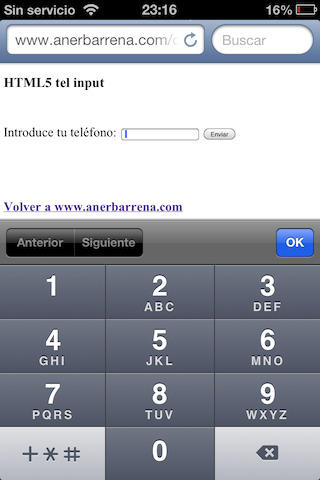
email input HTML5
Pues con este la validación de campos de email va a ser tarea sencilla.
El elemento por defecto detecta que el campo debe ser rellenado con contenido válido de una cuenta de email, por lo que mostrará una @ en el teclado y hara las verificaciones pertinentes para cumplir los requisitos de una dirección de email.
Tenéis más info en el post ‘HTML5 email input: Validación automática de emails en formularios‘.
Imagen de ejemplo.
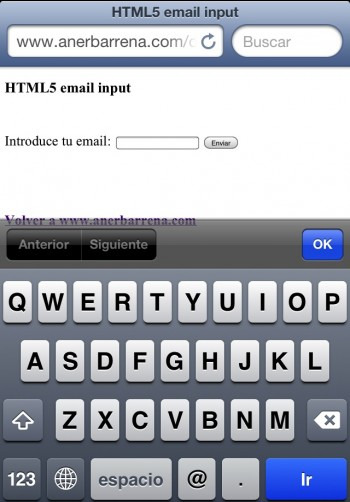
color input HTML5
Representa una paleta (selector) de colores sin necesidad de añadir plugins ni códigos adicionales como veníamos haciendo hasta ahora. Así con un solo click podemos elegir facílmente un color.
Los ejemplos los podéis ver en el post ‘HTML5 color input: Paleta de colores hexadecimal para formularios‘.
Imagen de ejemplo de la paleta de colores.
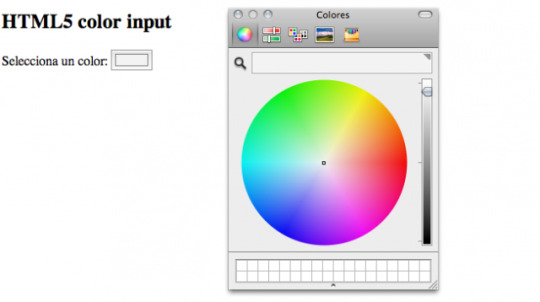
search input HTML5
Con este input podremos decir en la validación del formulario que el campo contendrá valores de búsqueda, así el propio input nos porporciona un dato válido y el teclado del dispositivo móvil mostrará el botón ‘buscar’.
Más info en esta entrada del blog ‘HTML5 search input: Campo de búsqueda para formularios‘.
Imagen de ejemplo.

url input HTML5
Se parece bastante a el input tel de HTML5. Este campo cuando se visualiza en dispositivos móviles facilita en el teclado las teclas ‘.’, ‘/’, y ‘.com’.
Más info en el post ‘HTML5 url input: Un campo de formulario para urls‘.
Ejemplo.

date input HTML5
Este elemento vale para representar en nuestra web un datepicker o calendario, el formato de la fecha devuelto es ‘AAAA-MM-DD’.
Podéis ver toda la documentación y ejemplos en el post original ‘Date input HTML5: Un sencillo datepicker para tu formulario‘.
Os dejo una imagen de ejemplo.
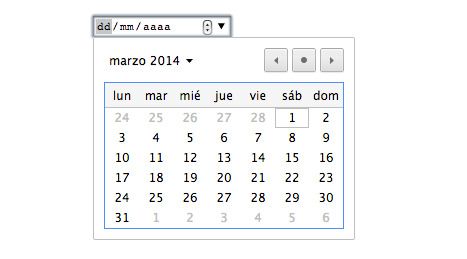
datetime input HTML5
Input similar al anterior solo que este último además de la fecha envía también la hora. El formato de fecha y hora devuelto es el siguiente: ‘AAAA-MM-DDTHH:MMZ’.
Podéis ver en funcionamiento y su documentación en el post ‘Datetime input HTML5: Un campo de fecha y hora para formularios‘.
Este elemento está sin implementar en casi todos los navegadores y solo funciona a medias en Safari.
datetime-local input HTML5
Más de lo mismo, elemento idéntico al datetime pero sin enviar la zona horaria. El formato devuelto es: ‘AAAA-MM-DDTHH:MM’.
Podéis consultar su sintaxis y funcionamiento en el post ‘Input datetime-local HTML5: fecha y hora local sin timezone para formularios‘.
Os dejo una imagen de ejemplo:

Month input HTML5
Input para representar mes y año con formato ‘AAAA-MM’.
Su documentación y ejemplos la podéis encontrar en ‘Month input HTML5: Un campo de tipo mes para formularios‘.
Os dejo un pantallazo de su representación:

Time input HTML5
Con la inserción de este elemento en un formulario facilitaremos la entrada de datos para horas, el formato de la info enviada es: ‘HH:MM:SS’.
Podéis ver una amplia explicación de su uso en ‘Time input HTML5: Un campo de formulario para introducir la hora‘.
Y aquí tenéis una imagen:

Week input HTML5
Por último nos queda el input para la inserción del número de la semana de un año en cuestión. Su formato es ‘YYYY-WNN’ –> ‘2014-W07’.
También tengo un post hablando sobre este elemento: ‘Week input HTML5: Un nuevo input para insertar semanas‘.
Os muestro una imagen de su funcionamiento:
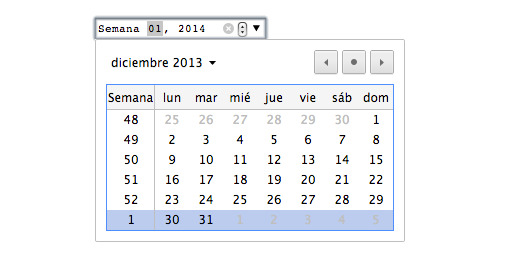
2) VALIDACIÓN DE FORMULARIOS CON HTML5 Y EXPRESIONES REGULARES SIN USO DE JS. UTILIZACIÓN DE CSS Y FONTAWESOME PARA MOSTRAR CAMPOS VÁLIDOS EN FORMULARIOS10 de
Con la nueva versión de HTML5 se han incluido dentro de los controles de formulario nuevos formatos que permiten especificar el tipo de dato a incluir en una etiqueta <input> y que explicaremos brevemente sólo como introducción. Mucho más interesante es el atributo pattern que estudiaremos. El atributo pattern permite en cualquier campo <input> de tipo texto y utilizando las sobradamente conocidas expresiones regulares delimitar exactamente la sintaxis de una cadena válida. Incluso con CSS3 y webfonts como Font Awesome podremos indicar de forma dinámica sin emplear JavaScript si el contenido de un campo es válido o no.
Pulsando sobre el siguiente botón tendrás acceso al ejemplo explicado en este artículo y a todo el código empleado.
Formulario con validación
ALGUNOS DE LOS NUEVOS TIPOS DE CAMPOS INTRODUCIDOS CON HTML5
No es ninguna novedad enumerar los nuevos tipos de campos introducidos por HTML5, pero siempre hay algún despistado. Es una forma bastante sencilla de incluir una validación básica simplemente delimitando el tipo de datos a incluir. Relaciono los más conocidos, pero ojo: hay algunos navegadores modernos que aún no los reconocen.
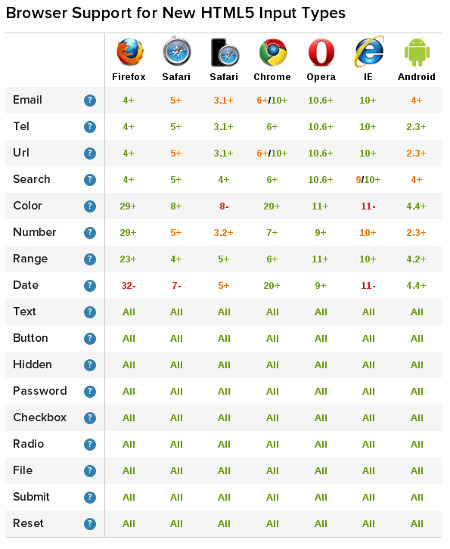

Si os interesa este es un buen recurso donde comprobar el soporte de formularios en distintos navegadores: http://www.wufoo.com.mx/html5/
type=”number” Podemos enviar enteros, estableciendo un mínimo y un máximo como input de texto.
type=”range” Podemos enviar enteros, estableciendo un mínimo y un máximo utilizando un control gráfico.
type=”color” Nos permite seleccionar desde un “color picker” un color y enviarlo como hexadecimal.
type=”date” Nos permite seleccionar una día concreto. En los navegadores más avanzados aparece un calendario.
type=”month”, type=”week”, type=”time” Nos permiten seleccionar distintas unidades de tiempo: mes, semana o año.
type=”email” Permite enviar una dirección de email con una pobre validación a nivel de cadena.
type=”url” Permite enviar una url con una pobre validación a nivel de cadena.
type=”tel” Para el envío de números de teléfono.
type=”search” Para definir campos de búsqueda, aunque realmente se comporta como un campo de tipo texto.
Si queréis conocer con más detalle el funcionamiento de estos nuevos controles de formulario os este enlace en W3Schools: http://www.w3schools.com/html/html_form_input_types.asp
Visto lo anterior en cierto modo podemos comenzar a tener cierto control sobre los tipos de datos que pueden admitir los campos input. Hasta ahora con el atributo maxlength podíamos establecer cual era la longitud máxima de una cadena (pero no su mínimo o fijar un tamaño exacto).
Ahora con la inclusión de tipos de datos como email, tel, date, number o url podemos afinar más en el tipo de dato válido. Sin embargo sigue sin ser suficiente.
VALIDACIONES CON EXPRESIONES REGULARES
Según wikipedia: Una expresión regular, a menudo llamada también regex, es una secuencia de caracteres que forma un patrón de búsqueda, principalmente utilizada para la búsqueda de patrones de cadenas de caracteres u operaciones de sustituciones.
Y esa misma posibilidad se ha añadido al control de validez de cadenas en los formularios de HTML5. Ahora mediante el atributo pattern, podemos añadir a los <input> de tipo texto como validación por medio de una expresión regular personalizada.
Imaginemos que queremos incluir en el típico formulario de alta que algunos de los campos como nombre, apellidos, email, usuario y contraseña pasen una validación de cadena.
Pongamos una serie de condiciones previas para cada uno de los campos:
Nombre: Admitiremos nombres de cualquier nacionalidad, incluyendo nombres compuestos y la mayoría de normas de acentuación. El número de caracteres será como mínimo 3 y como máximo 32. La verdad es que es una expresión regular ciertamente compleja, pero debemos de tener en cuenta la mayoría de las posibilidades. Esto nos dejaría un código similar a esto:
Apellidos: Del mismo modo aceptaremos cualquier carácter independientemente de la nacionalidad, con una tamaño entre 2 y 64 caracteres.
Email: HTML5 ya provee de un tipo de campo email, aunque su validación es bastante pobre. Podríamos complementarla con una expresión más compleja.
Usuario: Vamos a solicitar para el usuario de acceso al servicio una cadena de letras minúsculas, con un número opcionalmente de hasta dos dígitos al final. La cadena completa tendrá entre 5 y 12 caracteres.
<div> <label for="nombre">Nombre</label> <input type="text" name="nombre" id="nombre" pattern="[a-zA-ZàáâäãåąčćęèéêëėįìíîïłńòóôöõøùúûüųūÿýżźñçčšžÀÁÂÄÃÅĄĆČĖĘÈÉÊËÌÍÎÏĮŁŃÒÓÔÖÕØÙÚÛÜŲŪŸÝŻŹÑßÇŒÆČŠŽ∂ð ,.'-]{2,48}" required/> </div>
<div> <label for="apellidos">Apellidos</label> <input type="text" name="apellidos" id="apellidos" pattern="[a-zA-ZàáâäãåąčćęèéêëėįìíîïłńòóôöõøùúûüųūÿýżźñçčšžÀÁÂÄÃÅĄĆČĖĘÈÉÊËÌÍÎÏĮŁŃÒÓÔÖÕØÙÚÛÜŲŪŸÝŻŹÑßÇŒÆČŠŽ∂ð ,.'-]{2,64}" required/> </div>
<div> <label for="correo">Correo electrónico</label> <input type="email" name="correo" id="correo" pattern="^[a-zA-Z0-9.!#$%&’*+/=?^_`{|}~-]+@[a-zA-Z0-9-]+(?:\.[a-zA-Z0-9-]+)*$" required/> </div>
<div> <label for="usuario">Usuario</label> <input type="text" name="usuario" id="usuario" pattern="^([a-z]+[0-9]{0,2}){5,12}$" required/> </div>
Password: Por último vamos a solicitar una cadena como contraseña, la cual podrá contener letras mayúsculas, minúsculas, números y los caracteres !?-. Su tamaño: entre 8 y 12 caracteres.
<div> <label for="pass">Contraseña</label> <input type="password" name="pass" id="pass" pattern="[A-Za-z0-9!?-]{8,12}" required/> </div>
Con este sencillo código hemos puesto un ejemplo de formulario que simplemente no realizará el envío de datos hasta que todas las condiciones no se cumplan. Obviamente todos estos campos deberán de encontrarse dentro de un formulario HTML para funcionar.
Podrás encontrar más ejemplos de expresiones regulares en esta URL: http://html5pattern.com/ aunque Internet está plagada de páginas y ejemplos de expresiones regulares.
Sin embargo no nos vamos a detener aquí. Vamos a comprobar cómo podemos utilizar CSS para advertir al usuario si el contenido del campo es válido o no.
PSEUDOCLASES EN CSS PARA LA VALIDACIÓN
En CSS3 se añadieron dos pseudoclases relacionadas con la validez de los campos: :valid e :invalid que nos van a permitir dotar de mayor visibilidad a los errores y aciertos de los usuarios al completar los formularios. Por supuesto con un soporte desigual entre los distintos navegadores como verás en el siguiente gráfico:
Añadiendo un poco de CSS podemos hacer que sea un poco más vistoso el resultado válido al introducir un campo.
input:valid { background-color: #BBFFF0; }
AÑADIENDO UN POCO MÁS DE ESTILO CON FONT AWESOME
Como ya he hablado en otros posts soy un gran fan de las webfonts, que nos permiten incluir diseño gráfico de forma muy sencilla, fácilmente reutilizables y con una muy baja penalización en el rendimiento web.
Nuevamente voy a volver a utilizar CSS y Font Awesome para incluir algo más vistoso en la validación. Para ello incluyo en el header la página un link a Font Awesome.
<link href="//maxcdn.bootstrapcdn.com/font-awesome/4.2.0/css/font-awesome.min.css" rel="stylesheet">
A continuación incluyo el siguiente código HTML después de cada input, con el icono check que me proporciona Font Awesome.
<i class="fa fa-check check-ok"></i>
Por último solo quedan incluir las siguientes lineas CSS que me permiten por medio del selector de siblings (hermanos o parientes) mostrar el check cuando el contenido del input sea válido u ocultarlo cuando no.
.check-ok { color: lime; } input:invalid ~ .check-ok { display: none; } input:valid ~ .check-ok { display: inline; }
Con esto ya tendremos completamente operativo el formulario, mostrando además un check al lado del campo en cuanto los datos introducidos sean válidos.
CONCLUSIÓN
En este artículo hemos podido ver cómo las nuevas posibilidades de añadir validación con expresiones regulares en HTML5 a los campos de formulario han mejorado bastante las posibilidades y ya no hacen tan imprescindible el uso de JavaScript en formularios pequeños. Sin embargo, ¿esto hace innecesario JavaScript? Personalmente opino que no, salvo en formularios muy sencillos como este. Paso a argumentar dicha opinión.
Se mezclan las capas de validación y presentación en nuestro código. Algo que prefiero mantener diferenciado teniendo por un lado la capa de presentación en HTML y la validación con programación Javascript.
Existen algunos tipos de validaciones que exigen programación. Funciones como por ejemplo la típica en el que se nos solicita incluir dos veces una contraseña para su cotejamiento con otro campo del formulario anterior, que sólo es posible realizar por JavaScript dado que requiere una comparación con otro valor.
Exige estar repitiendo una y otra vez los patrones en cada campo aunque sean los mismos. Algo que en las librerías de JavaScript está mucho mejor resuelto. Existen numerosas librerías, muchas de ellas basadas en jQuery, y que hacen incluso más sencilla la implementación de validación en formularios sin la necesidad de conocer expresiones regulares.
El soporte de ciertos tipos de campos no están implementados en todos los navegadores o de forma desigual. Además de que aún tenemos un importante número de usuarios que siguen funcionando con IE9… Lo de siempre: la única manera de mantener un interfaz unificado todavía sigue siendo el empleo de librerías JS como JQueryUI o validadores como JQuery Validator.
En cualquier caso aquí dejo el ejemplo y mis reflexiones por si a alguien le interesa. Estoy abierto a vuestras opiniones y comentarios.
TOMADO DE:
1)http://www.anerbarrena.com/nuevos-input-html5-3739/
2) https://oscargascon.es/validacion-de-formularios-con-html5-y-expresiones-regulares-sin-uso-de-js-utilizacion-de-css-y-fontawesome-para-mostrar-campos-validos-en-formularios/
0 notes
Link
Line25 http://j.mp/2rnQxFK
Looking for some amazing date pickers designs? Well, look no further! This article gathers some excellent Javascript libraries that you can download and use right away.
Date pickers resemble a calendar’s design although they have a different functionality. These elements come in handy when you need to select a certain date from a calendar or from a specific time range. They sometimes have a dropdown animation that is enabled when clicked on the specific field.
You can use date pickers in various situations when you need to set a certain date, for instance, plane tickets, booking a vacation, an accommodation, rental, etc.
These designs have highly customizable features that allow you to create everything as you want, according to your style. You can download and integrate them in both websites and mobile applications, depending on your requirements. These date pickers have a responsive behavior and will automatically adapt to perfectly fit any screen size.
Flatpickr
This is a neat date picker with a simple but effective design. Download this flat design item and integrate it in your current or upcoming projects.
DateBox
DateBox is a great jQuery plugin which has a very intuitive design. You can quickly add it to your projects and use its functionalities.
Continuous Calendar
This data picker can be used to select continuous dates from a specific time range. Have a closer look and see if this is useful to your designs.
Material-date time-picker
This is a well-designed date picker that was specially created for web apps. It has a similar design to a calendar but with different functions.
React Infinite Calendar
Here is a stunning infinite date picker that uses infinite scrolling, has a flexible design, customizable characteristics, and other great features.
Rome
This is a beautiful date picker layout which includes menu customizable features. Take a look and see if you can use it in your current projects.
DateTime Picker
Here you have another wonderful date time picker with a fully responsive layout that automatically adapts its content to various sizes.
Tiny Date Picker
This is a lightweight date picker with zero dependencies. It has a clean and simple design that looks amazing on any website or app.
Date Range
This is a great date picker that allows you to select a date range. It also counts and displays the number od days that you’ve selected.
DateTimePicker
Download and use this wonderful date picker and use it in your websites or applications. You can also use the scroll to select the exact day.
glDatePicker
This is a great date picker that you can download and quickly integrate into our projects. This item has a highly customizable design.
Timepicker
This is an amazing date picker which includes multiple hours, minutes, days, pickers. Browse through all and see which ones you require.
Zebra Datepicker
This date picker has a small design with customizable characteristics. Download and add it to your website or app design for amazing results.
Filthypillow
Here you have another amazing date picker that you can download and use in your designs. Have a look and see if this item fits your style.
DatePicker
This is a neat date picker which includes lots of editable features directly from CSS. It has a flat style and can be perfect for various situations.
jQuery UI DateRangePicker
This is a wonderful jQuery UI date picker that you can also use to select a time range from a specific period. This will definitely come in handy at some point.
Simple DateTimePicker
Here you have a great date picker with a simple but effective minimalistic design. You can customize its features until you are happy with the result.
PickMeUp
This date picker functions on a simple but powerful concept that makes it look amazing in multiple projects. Discover its full features and use it in your digital projects.
jCal
You can use this lovely date picker to quickly select a number of days, for example, 4. This item has also lots of customizable features that will help you create the design that you like.
Datepair.js
You can use this date picker to select specific dates from a calendar. This item has an excellent drop-down layout with a highly customizable design.
The post Date Pickers | 20 Javascript Libraries You Can Use appeared first on Line25.
http://j.mp/2roiBIT via Line25 URL : https://line25.com
0 notes